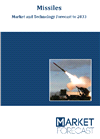Naval Air Warfare Center Weapons Division successfully air-launched a Solid Fuel Integral Rocket Ramjet (SFIRR) from an unmanned vehicle for the first time, one step toward modernizing missile technology.
The test also integrated the use of a fire control system on a BQM-34 unmanned target vehicle for live firing, demonstrating advancements in high-speed, long-range weapon capabilities. Launching the missile from an unmanned vehicle can allow warfighters to safely engage targets from greater distances.
As the Lead Prototype Integrator, NAWCWD combined advanced propulsion, avionics and fire control technologies into the technology demonstrator in just 12 months. Rapidly transitioning technologies from research to operational use is critical for maintaining a warfighting advantage.

Market forecast by Regions, Types, Guidance systems, and Launch Platforms. Country Analysis, Market and Technology Overview, Critical Raw Materials, Opportunity Analysis, and Leading Company Profiles
Download free sample pages More information"This successful integration validates key aspects of our design and moves us closer to delivering an advanced propulsion system that will provide warfighters with greater range and speed," said Abbey Horning, product director of NAWCWD's Advanced Concepts, Prototyping and Experimentation office.
Although Solid Fuel Ramjet technology is not new, this test proves its relevance to the modern battlefield.
"We're not just revisiting an old idea; we're refining and modernizing it to fit today's mission," Horning said.
SFIRR simplifies missile propulsion by eliminating the complexity found in liquid fuel ramjet propulsion. This significantly reduces weight, allowing missiles to carry more payload and travel greater distances with increased maneuverability.
Horning highlighted additional benefits: "SFIRR offers a balance of affordability, reliability and performance tailored to the Navy's operational needs."
Ephraim Washburn, deputy director for energetics at NAWCWD, noted that technology evolution occurs across many industries. He compared SFIRR advancements to automotive improvements, where early designs laid a foundation, and ongoing developments continue to enhance performance.
"We've been driving cars since the early 1900s, but that doesn't mean we stopped improving them," Washburn said. "Solid fuel ramjet technology had significant investment in the 1970s and 1980s, but we're making it a modern propulsion solution for the fleet today."
These recent advances are part of the Navy's ongoing efforts to ensure technological superiority. NAWCWD collaborates across government, industry and academia to deliver propulsion innovations. Lessons learned from recent tests directly informed the development of a next-generation missile prototype aimed at enhancing speed, range and operational flexibility for future Navy strike capabilities.
"This is a combat-credible technology," Washburn said. "We are working to refine its range, endurance, and targeting capabilities."